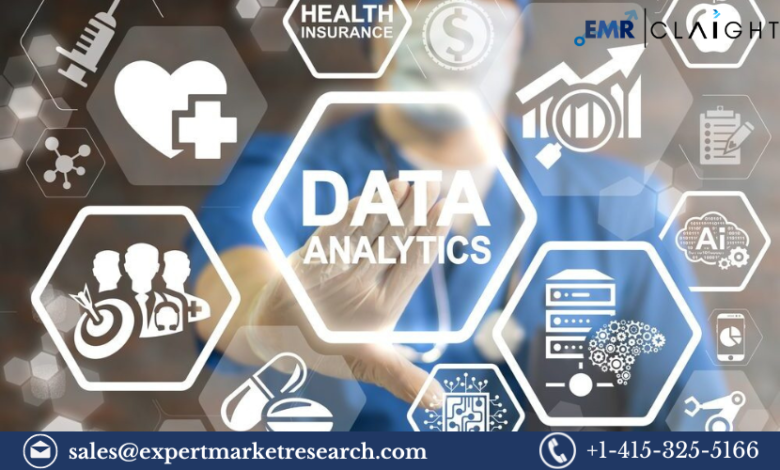North America Clinical Data Analytics in Healthcare Market Report 2024-2032
North America Clinical Data Analytics in Healthcare Market Insights

I. Introduction
A. Overview of Clinical Data Analytics in Healthcare
Clinical data analytics involves the use of advanced analytical techniques to interpret and leverage healthcare data, such as electronic health records (EHRs), patient information, and clinical trial data. This field is critical for improving healthcare outcomes by enabling more informed decision-making, enhancing operational efficiencies, and driving innovations in patient care. It encompasses various methodologies including predictive, prescriptive, and descriptive analytics, which help in forecasting future trends, optimizing treatment plans, and understanding historical data patterns.
B. Market Size and Growth
As of 2023, the North American clinical data analytics in healthcare market was valued at USD 13.14 billion. This figure highlights the significant investment and adoption of data analytics technologies in the region. The market is anticipated to experience substantial growth, projected at a compound annual growth rate (CAGR) of 9.9% between 2024 and 2032. By 2032, the market is expected to reach USD 32.01 billion. This robust growth is driven by increasing healthcare data volumes, advancements in analytics technologies, and the growing need for data-driven insights in healthcare management.
II. Market Dynamics
A. Driving Factors
- Increasing Adoption of Electronic Health Records (EHRs): The widespread adoption of EHRs has been a major catalyst for the growth of clinical data analytics. EHRs provide comprehensive patient information that can be analyzed to improve clinical outcomes, streamline workflows, and reduce errors.
- Rising Demand for Data-Driven Decision-Making: Healthcare organizations are increasingly relying on data analytics to make informed decisions regarding patient care, operational efficiencies, and financial management. This shift towards data-driven approaches is enhancing the quality of care and operational effectiveness.
- Advancements in Big Data and Analytics Technologies: Technological advancements in big data analytics, machine learning, and artificial intelligence are revolutionizing the way healthcare data is processed and analyzed. These technologies enable more accurate predictions, personalized treatments, and efficient data management.
- Growing Focus on Personalized Medicine: Personalized medicine, which tailors treatment plans based on individual patient data, is gaining traction. Clinical data analytics supports personalized medicine by providing insights into patient-specific responses to treatments, leading to more effective and targeted healthcare solutions.
B. Restraining Factors
- High Implementation Costs: The initial costs associated with implementing clinical data analytics solutions can be significant. This includes costs for software, hardware, and training, which can be a barrier for smaller healthcare providers.
- Data Privacy and Security Concerns: The handling of sensitive patient data raises concerns about data privacy and security. Healthcare organizations must ensure compliance with regulations such as HIPAA, which can complicate the implementation and management of data analytics systems.
- Lack of Standardized Data Formats: Inconsistent data formats and standards across different systems and organizations can hinder the integration and analysis of healthcare data. This lack of standardization complicates data sharing and interoperability.
C. Opportunities
- Expansion into Emerging Markets: There is significant growth potential in emerging markets, where the adoption of clinical data analytics is increasing. Companies that can navigate these markets effectively may benefit from new revenue streams and partnerships.
- Development of Advanced Analytics Solutions: The continuous evolution of analytics technologies presents opportunities for developing more sophisticated solutions. Innovations such as real-time analytics, advanced machine learning models, and predictive analytics offer competitive advantages.
- Strategic Partnerships and Collaborations: Collaborating with technology providers, research institutions, and healthcare organizations can enhance the development and adoption of clinical data analytics solutions. Strategic partnerships can lead to shared resources, knowledge, and market expansion.
D. Challenges
- Integration with Existing Systems: Integrating new analytics solutions with legacy healthcare systems can be complex and resource-intensive. Ensuring compatibility and seamless data flow between systems is a significant challenge.
- Regulatory and Compliance Issues: Navigating the regulatory landscape and ensuring compliance with healthcare regulations can be challenging. Organizations must stay updated with regulatory changes and implement measures to address compliance requirements.
- Ensuring Data Accuracy and Quality: High-quality data is crucial for effective analytics. Ensuring data accuracy, completeness, and consistency is essential to deriving reliable insights and making informed decisions.
Get a Free Sample Report with Table of Contents
III. Market Segmentation
A. By Component
- Software: This segment includes various software solutions used for data analysis, visualization, and reporting. Software tools enable healthcare providers to manage and interpret large volumes of data effectively.
- Services: This includes consulting, implementation, and support services related to clinical data analytics. Services help healthcare organizations adopt and optimize analytics solutions, ensuring they derive maximum value from their investments.
B. By Application
- Predictive Analytics: Predictive analytics involves using historical data to forecast future trends and outcomes. In healthcare, it can predict patient health risks, treatment responses, and disease outbreaks.
- Prescriptive Analytics: Prescriptive analytics provides recommendations for actions based on data insights. It helps healthcare providers in decision-making by suggesting optimal treatment plans and operational strategies.
- Descriptive Analytics: Descriptive analytics focuses on summarizing and interpreting historical data to understand past events. It provides insights into trends and patterns, aiding in the evaluation of past performance and outcomes.
C. By End-User
- Hospitals and Clinics: These are primary users of clinical data analytics, leveraging it to improve patient care, streamline operations, and enhance clinical decision-making.
- Research Organizations: Research institutions use data analytics to analyze clinical trials, study patient outcomes, and conduct health-related research.
- Healthcare Payers: Insurance companies and other healthcare payers utilize analytics to manage claims, assess risk, and optimize financial performance.
D. By Region
- United States: The U.S. holds a significant share of the North American market, driven by advanced healthcare infrastructure, high adoption rates of technology, and substantial investments in data analytics.
- Canada: Canada’s market is growing due to increasing healthcare digitization, government initiatives to enhance data utilization, and a focus on improving healthcare delivery through analytics.
IV. Key Players and Competitive Landscape
A. Overview of Major Players
- Altera Digital Health Inc: Specializes in healthcare IT solutions, including data analytics platforms that improve patient care and operational efficiencies.
- Oracle Corporation: Offers a range of healthcare analytics solutions, including cloud-based data management and analytical tools that support data integration and advanced analytics.
- IBM Corp.: Provides AI-powered analytics solutions and services, including IBM Watson Health, which leverages data analytics to enhance clinical decision-making and research.
- Koninklijke Philips N.V.: Focuses on integrated data analytics solutions that support personalized healthcare, clinical performance, and patient management.
- eClinical Solutions LLC: Offers a comprehensive suite of data analytics and clinical trial management solutions designed to streamline research processes and improve clinical outcomes.
Best Trending Reports
Chlorpheniramine Maleate Market




